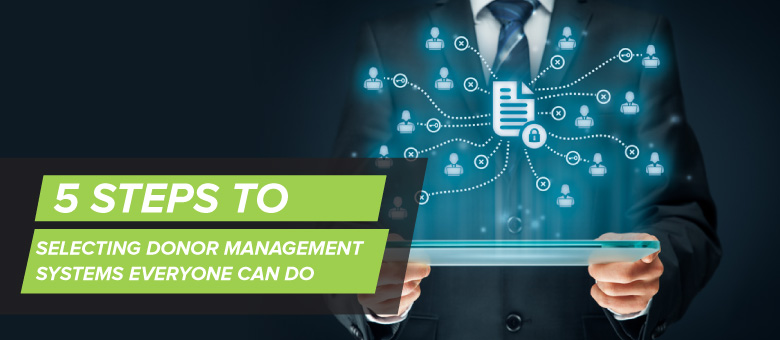
Every single nonprofit that engages in fundraising will, at some point, face the task of selecting the best Donor Management/CRM System for the organization.
This task does NOT need to be daunting!
After all, we are living in an age where more information than we will ever need is literally a few keystrokes away. However, no matter how much information is out there, without a game plan the task can take dangerous twists and turns.
Here are five steps to keep you and your team on the path to system selection success and therefore fundraising success:
- Define Your Future Fundraising Goals
- Research Third-Party Rating Sites
- Research Your Top Three to Four Funding Areas
- Perform Proper Reference Checks
- Determine Your Best Partner for the Long-Term
Let’s get started.

1. Define Your Future Fundraising Goals
The best place to begin is to fully outline your current funding mix. This is often represented with a chart showing how many dollars have been raised in the last year from your funding sources. Here are the common ones:
- Individual Giving, possibly broken out into:
- Direct Mail
- Major Gifts
- Legacy Gifts
- Special Events
- Online Giving
- Corporate Gifts/Sponsorships
- Grants (Both Government and Foundation)
- Service Fees
- United Way
- Other
Show the dollars raised or percentage for each group then create a new chart looking ahead for the next five years. In other words, determine what aspects of your funding mix are most important to your future. Then, use this as a guide to the functions most important for your new donor management system to handle flawlessly.
Once you know your funding mix for the future, rank them in order of importance from largest to smallest. Since no system will handle each type of fundraising activity perfectly, you will know where to look for system strengths.
Most forward looking analysis will find that major gifts and legacy gifts comprise the largest portions of the funding mix. This will point to everyone who interfaces with donors being able to easily use the system daily. These means keeping the system very intuitive, if not easy to use. Clearly, far different than just having a system administrator using it!
Once you know your mix you are about ready to contact suppliers. More on how to do this in Step 2 below.
A final thought to keep in mind: This first step is not about checking or even defining a budget yet. Most nonprofits are hindering their future objectives and goals when they look at previous or current budget parameters, since they were based on past fundraising performance. Once you establish your future goals, then set your budget levels.

2. Research Third-Party Rating Sites
Before contacting any system suppliers there are several excellent third-party websites collecting and presenting user reviews. Needless to say, but this allows you to quickly see what customers are using each of the systems for, how well it is working for them, and perhaps most important, the level of implementation expertise and ongoing support.
You should be able to discern the top two or three system suppliers to contact. I highly suggest no more than two or three to avoid the inevitable confusion that contacting more brings.
Please note: The best system suppliers will take a consultative approach and actually conduct an analysis of your needs in each funding area before ever showing you a demonstration. They will customize the demo to focus in on what you will be using to reach your future fundraising goals!
Here are the most comprehensive third-party sites:
- G2 Crowd
- Software Advice
- Capterra
Sometimes, it can also be helpful to review the “top providers” pages provided by other names in the industry that you know and trust. For instance, you may find this guide by Double the Donation informative.
However, this should never be your only source of referral data! Companies may have other motives that might lead them to adding people to their referral lists (such as partnerships or other deals). These referral lists can be a great start to your research though! It can give you additional names to look up on third-party review sites.

3. Research Your Top Three to Four Funding Areas
Once again, the internet can come in quite handy here. Begin with your top three to four funding mix areas of the future, and search current best practices for each.
You will find best practices coming from proven research into each area. You will also find nonprofit fundraising experts blogging about best practices.
Here are a few places to find top notch research around best practices and case studies based upon funding areas:
- Bloomerang’s Recently Funded Projects
- Institute for Sustainable Philanthropy Reports
- IUPUI School of Philanthropy Current Research Projects
Knowing the best practices for each of your funding areas will allow you to be better prepared to evaluate what is being offered by system suppliers.
Please note: Cloud-based systems, one topic likely to emerge in your research, not only greatly reduce the need for internal IT assistance while increasing security, but also provide ongoing access to such key functions change of address updates, prospect research, email, etc.

4. Perform Proper Reference Checks
System reference checking is an area where it is quite easy to go off track. If you just call a person using any system they have recently chosen, you will seldom hear anything but glowing remarks.
You can avoid this by using key questions to guide the conversation or better yet, the email discussion. A smartly crafted email asking specific questions will work extremely well in this area. It also saves time and fully documents your research efforts!
Here are some top-notch questions to use:
- Explain how the conversion of your data was handled?
- Was the converted data usable from the start?
- Describe the rest of the implementation process?
- How happy are you with the ongoing support?
- How does it compare to support you have with other products?
- Were you happy with the sales/purchasing/billing processes?
- Are you integrated with your email and website?
- How happy are you with those and any other integrations?
- What would you do differently if you were purchasing a new system in the future?
- What is the best and worst part of working with your current supplier?
- Have your fundraising results improved since you began using?
- What else should I know about your current system?
The questions above should allow you to hone in on key differentiators, as well as, avoiding future problems often associated with system changes.

5. Determine Your Best Partner For the Long-Term
Although product fit will improve your fundraising results in most of your key funding areas, there are numerous other factors to consider before picking your system supplier partner for the future.
Notice the section header uses the words “Long-Term Partner”!
Just like in number four above, there are several key questions to ask references so that you can avoid an unreliable long-term partner. In this case, the questions most definitely should be asked via email, so you have a complete written response as well as the additional documents requested.
The answers to these questions will quickly pinpoint the partner you will want to be with for the next ten years. The answers will often change the ranking order of system suppliers.
Here are the best partner related questions to ask:
- What are you support hours?
- Is customer support unlimited?
- How many years has your company been in existence?
- Has there been a change in ownership during any of that time?
- Have your prices increased any in the last 10 years? If so, how often and by what percentage?
- Is your company currently profitable?
- How many full time employees are on staff?
- Are your company financial statements audited? If yes, please provide a copy of the most recent statements. If not, please still provide a current income statement and balance sheet.
- Is your company funded by Venture Capital or P/E Firms? If so, who are they and what were the funding dates and amounts?
- What percentage of your company’s business revenue is from nonprofit customers?
- Will a specific project manager be assigned to us during the implementation and conversion process?
- Will the data conversion have multiple iterations for data checking purposes?
- How many customers are using the same version of the same system we will be using?
The questions above are almost always asked by any commercial business when they purchase anything major such as CRM system, however they are often overlooked by nonprofits when making key purchases.
Choosing a poor long term partner need not be the case, since it is easy to ascertain who will be the best system supplier partner/long term partner from the questions above.
Please note: Having a good long term partner is critical for nonprofits since there is often high staff turnover, very little internal IT assistance, and the need for a strong nonprofit CRM system to support the funding of the mission!
Summary
As you can see, thanks to the internet, you can now make sound system supplier decisions for your donor database without being a techie. In fact, anyone can make sound decisions using the five steps outlined above. Simply using on-line research and the proposed questions will guide you to a system that fits your needs. Just as important, if not more so, your will have a long term partner to guide and help you along the journey to mission funding success!
About the Author
 Steven Shattuck is Chief Engagement Officer at Bloomerang and Executive Director of Launch Cause. A prolific writer and speaker, Steven is a contributor to “Fundraising Principles and Practice: Second Edition” and volunteers his time on the Project Work Group of the Fundraising Effectiveness Project and is an AFP Center for Fundraising Innovation (CFI) committee member.
Steven Shattuck is Chief Engagement Officer at Bloomerang and Executive Director of Launch Cause. A prolific writer and speaker, Steven is a contributor to “Fundraising Principles and Practice: Second Edition” and volunteers his time on the Project Work Group of the Fundraising Effectiveness Project and is an AFP Center for Fundraising Innovation (CFI) committee member.






Leave A Comment